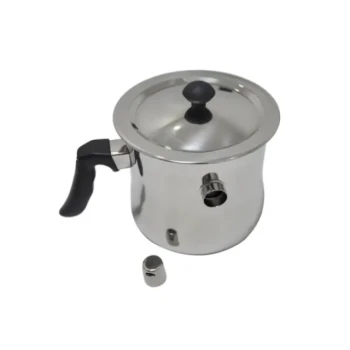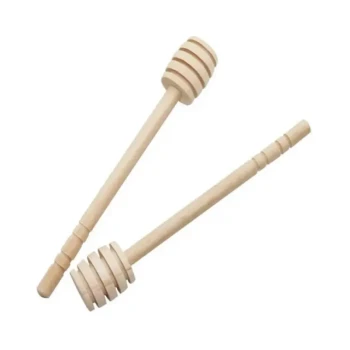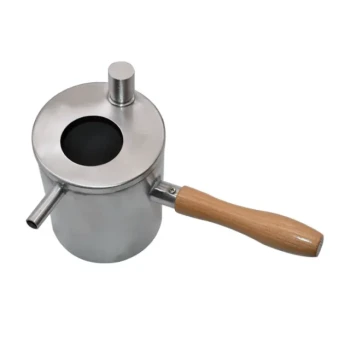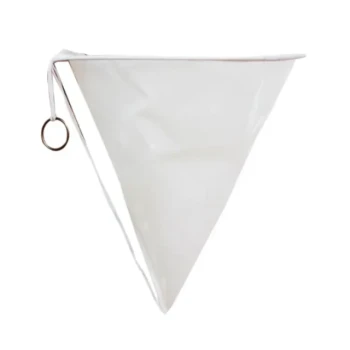To use honey that has hardened, simply warm it gently. Place your sealed jar of honey in a bowl of warm (not boiling) water and let it sit. The crystals will slowly dissolve, returning the honey to its smooth, liquid state without damaging its quality.
Crystallization is not a sign of spoilage—it's a natural process that happens to all pure honey. The honey is perfectly safe and delicious, and this hardening can be easily reversed with gentle heat.
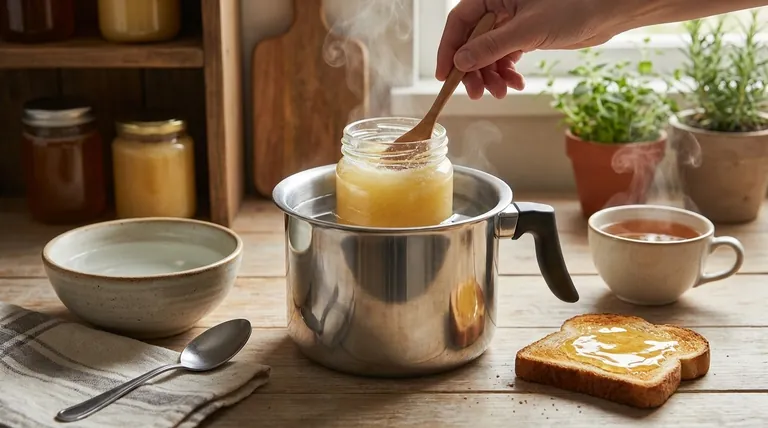
Why Honey Hardens: The Science of Crystallization
Understanding why your honey has turned solid is the first step to realizing it hasn't gone bad. In fact, for raw, unfiltered honey, it's a sign of authenticity.
A Natural and Reversible Process
Honey is a supersaturated solution, meaning it contains more sugar than can naturally remain dissolved. This makes the solution unstable, and over time, the sugar will begin to form solid crystals.
The Role of Glucose and Fructose
Honey is primarily composed of two sugars: glucose and fructose. Glucose is much less soluble in water than fructose, so it's the glucose that forms the initial crystals.
The ratio of these two sugars determines how fast honey will crystallize. Honeys with a higher glucose content (like clover or dandelion honey) will harden much faster than those with a higher fructose content (like acacia or tupelo honey).
Factors That Speed Up Crystallization
Several things can accelerate this process. The main culprit is temperature. Storing honey in a cool place (like a chilly pantry or the refrigerator) will significantly speed up crystal formation. The presence of tiny particles, like pollen or beeswax, can also act as "seeds" for crystals to grow on.
The Correct Way to Re-liquefy Honey
The goal is to melt the glucose crystals without overheating the honey, which can destroy its delicate enzymes and aromas.
The Gentle Water Bath Method
This is the safest and most effective technique. Fill a bowl or pot with warm water. Do not use boiling water.
Place your sealed jar of honey into the water bath. Be patient, as it may take 20-60 minutes depending on the size of the jar and the extent of the crystallization. The gentle, indirect heat will dissolve the crystals perfectly.
Handling Plastic vs. Glass Jars
This method works for both glass and plastic containers. However, be extra cautious with plastic, as excessively hot water can warp the container or potentially leach chemicals. A glass jar is always the superior choice for warming.
What If It's Just a Little Hard?
You don't always have to re-liquefy the entire jar. Crystallized honey is perfectly edible. You can simply scoop it out and use it as a delicious, spreadable treat on toast or stir it into hot tea where it will dissolve instantly.
Common Pitfalls to Avoid
How you re-liquefy honey is just as important as the method itself. Rushing the process can do more harm than good.
The Microwave Trap
Microwaving honey is fast, but it's a terrible idea. Microwaves heat unevenly, creating hot spots that can scorch the honey, destroying its beneficial enzymes and delicate flavor. It can also easily melt or superheat a plastic container, making it unsafe.
The Dangers of Direct Heat
Never heat honey directly in a pot on the stove. Just like with a microwave, the intense and direct heat will caramelize the sugars and degrade the honey's quality, turning it into a simple sugar syrup. Gentle, indirect heat is the only safe approach.
How to Apply This to Your Honey
Your approach depends on your immediate goal and how you plan to use the honey.
- If you just need a spoonful for tea or toast: Scoop it out directly. The crystallized texture is enjoyable and melts easily in heat.
- If you need pourable honey for baking or drizzling: Use the gentle warm water bath method to restore its smooth, liquid consistency.
- If you want to slow future crystallization: Store your honey at a stable room temperature, preferably in a warm corner of your pantry, and never in the refrigerator.
Understanding this natural process ensures you can enjoy your honey to the very last drop.
Summary Table:
| Method | Best For | Key Consideration |
|---|---|---|
| Gentle Warm Water Bath | Restoring entire jar to liquid state | Use warm, not boiling, water. Ideal for glass jars. |
| Scoop & Use Directly | Adding to hot tea or spreading on toast | Crystallized honey is safe, delicious, and spreadable. |
For Beekeepers & Distributors: Ensure Your Customers Enjoy Perfect Honey Every Time
As honey crystallization is a natural process, providing high-quality beekeeping supplies is key to producing premium honey. HONESTBEE supplies commercial apiaries and beekeeping equipment distributors with the durable, reliable tools needed for efficient honey production and processing.
We help you:
- Maximize Honey Quality: From extraction to storage, our equipment helps maintain honey's natural properties.
- Streamline Operations: Our wholesale-focused solutions are designed for scale and efficiency.
Let's discuss your supply needs. Contact our team today to learn how our products can support your business.
Visual Guide
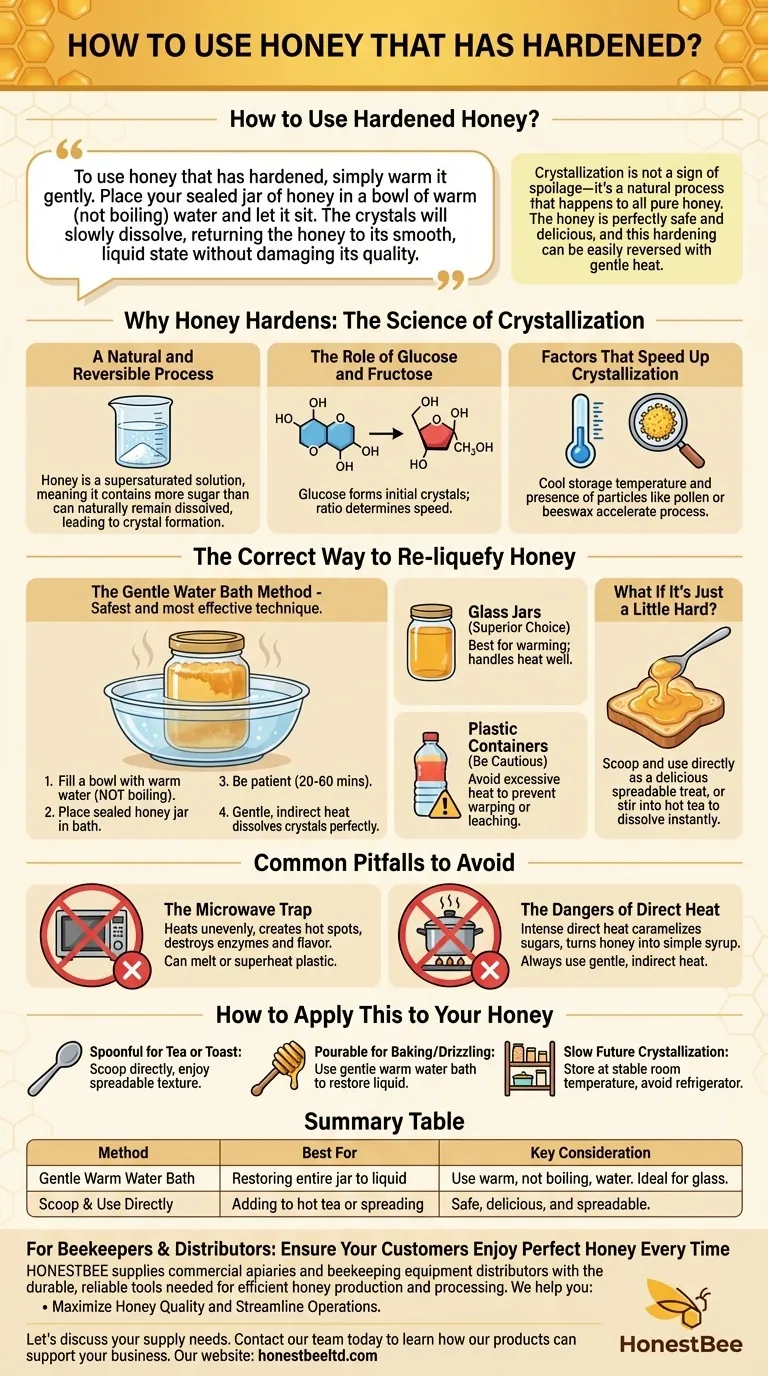
Related Products
- Beeswax Melter for Candle Making Honey Bee Wax Melter
- 10L Stainless Steel Electric Honey Press Machine
- HONESTBEE 72 Frame Industrial Electric Honey Extractor for Beekeeping
- 8-Frame Electric Self-Reversing Honey Extractor Spinner for Commercial Honey Extraction Equipment
- 24 Frame Honey Extractor Commercial Radial Honey Frame Extraction Machine
People Also Ask
- What is the flashpoint of beeswax? Essential Safety and Quality Tips for Beekeepers
- What are the main types of wax melters? Choose the Right Heating Method for Your Needs
- How do water jacket melters function? Achieve Gentle, Scorch-Free Melting for Sensitive Materials
- What is the recommended temperature range for melting beeswax? Achieve Perfect Quality & Safety
- What makes polyurethane foam environmentally friendly? The Surprising Benefits of a Durable, Inert Material
